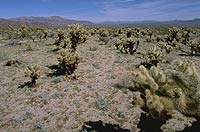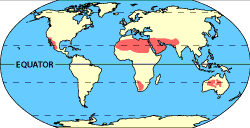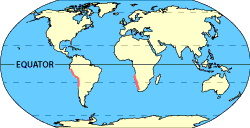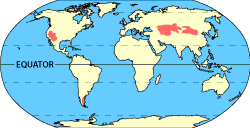Topic Overview: Deserts
 Most people think of deserts as hot, sandy places. That is not always true. Desert biomes are simply places that are dry much of the year. They can be found all over the world. There are deserts in some tropical regions. There are also deserts on the backsides of mountains. Deserts form anywhere there is little water. Deserts even form in very cold places. Water in these places is frozen. The plants and animals cannot use it. To them, the land is dry. It is a desert. Photo: Cholla Cactus Garden in Colorado Desert at Joshua Tree National Park. Most people think of deserts as hot, sandy places. That is not always true. Desert biomes are simply places that are dry much of the year. They can be found all over the world. There are deserts in some tropical regions. There are also deserts on the backsides of mountains. Deserts form anywhere there is little water. Deserts even form in very cold places. Water in these places is frozen. The plants and animals cannot use it. To them, the land is dry. It is a desert. Photo: Cholla Cactus Garden in Colorado Desert at Joshua Tree National Park.
There are many types of deserts. The climate is different in each type of desert. Therefore, the plants and animals that can live in each type of desert are different. Since deserts are dry, very few plants can grow there. That means there is little shade to block the sun's light. This causes most deserts to be much warmer during the day than at night.
Berkeley's Biomes group divides the deserts of the world into four main groups. They are hot and dry, semi-arid, coastal, and cold.
Hot and dry deserts can be found in North America, Central America, South America, southern Asia, Africa, and Australia. Well-known hot and dry deserts include the Mojave and the Sahara. As the name suggests, these deserts are very hot and very dry. They have two seasons: hot and hotter! It seldom rains in these deserts. When it does, the rain falls in short downpours.

Plants in these deserts must survive long dry periods. They must also survive very hot days and very cold nights. To do this, most plants in hot and dry deserts grow close to the ground. Prickly pears, turpentine bush, and yuccas grow in these deserts. Most animals in hot and dry deserts live underground. It is cooler there. Some also avoid the heat by coming out only at night. These animals are called nocturnal. Since it is so hot and dry, there are few large mammals in these deserts. Kangaroo rats, snakes, lizards, and insects live in hot and dry deserts.
Semiarid deserts can be found in North America, Europe, and northern Asia. These deserts are a lot like the hot and dry deserts. They have long, dry summers. They also receive little rain during the winters. However, semiarid deserts do not get quite as hot during the day as hot and dry deserts. They do not get quite as cold during the night either. Semiarid deserts are also similar to the chaparral and grassland biomes. Semiarid deserts are so much like these other biomes, they are often not recognized as a class all their own. Many maps—including the one on this site—do not display this biome at all.
Many plants in semiarid deserts grow spines or hairs. Spines and hairs shade the plants' surfaces. That reduces water loss. Plants in semiarid deserts also have glossy leaves. They reflect the sun's light. Bur sage, creosote, and mesquite grow in semiarid deserts. Some types of rabbits along with kangaroo rats, snakes, and lizards live in these deserts too.
Coastal deserts can be found in parts of Chile in South America. Like all deserts, coastal deserts are dry. However, these deserts are not hot. Coastal deserts have cool winters. They also have warm summers. The mild summer season is longer than the winter.

Black sage, rice grass, and salt bush are plants that grow in coastal deserts. More types of animals can live in these deserts than in hot and dry and semiarid deserts. That is because coastal deserts are not as harsh. Mammals like coyotes can live in these deserts. Even some amphibians can live there. Amphibians are animals that must spend part of their life in water. Birds and snakes live in these deserts too.
Cold deserts can be found in the Antarctic (South Pole), Greenland, and parts of North America. Cold deserts have two seasons. They have long, cold winters. A lot of snow falls during the winter season. They also have short summers that are warm and moist.

It seems strange to think of a cold place as being a desert, but it can be. Remember that deserts are simply places that are dry during much of the year. Cold deserts receive most of their precipitation as snow. Because it is so cold in these places, the snow stays frozen for a long time. There is very little liquid water. Therefore, these places are dry. They are deserts.
Most of the plants in cold deserts are scrubs. Scrubs are short brush and trees. The cold desert scrubs are deciduous plants. Deciduous plants lose their leaves in the winter. Most of the animals in cold deserts burrow underground to avoid the extreme cold. These animals include badgers, foxes, and many types of mice. Photo courtesy of Philip Greenspun. |











